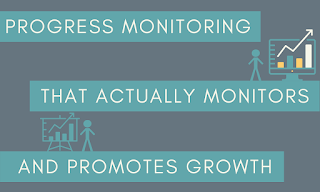Progress Monitoring: My students hated it and so did I. So, we changed it.
The first group that I had was an 8th grade ELA group and as soon as I announced that we were progress monitoring, they all groaned. I was surprised because they were a pretty amiable crew. I asked them why they dreaded progress monitoring and they told me a few important things.
1. First, to them, it seemed pointless. They took the time to complete the probe and then never saw their work ever again. They never knew what they scored or where their work was going.
2. The work seemed foreign to them. They said that the probes never reflected anything that they did in class, and it was too difficult.
3. It was time consuming. Everything paused once a week to do progress monitoring.
Of course, we had to do the progress monitoring probes either way, but I kept this in mind. Over the summer, I decided to develop a new system for progress monitoring. I had not seen a significant amount of growth on the probes, I could not see the connection between the probes and our class activities, I was tired of wasting time, and I was tired of students rushing through the probes to finish them. Here are the changes that I implemented:
1. I found new probes that were both on grade-level and a reasonable length.
2. I kept the hardcopy progress monitoring folders, but I also created a chart in excel to track and average progress monitoring scores. This way, I could clearly see the students’ goals and progress each week.
3. I created charts for the students to use to mark their progress each week. I shaded the area that fell within their goal, and I charted their baseline.
4. Feedback became instantaneous. Each week, I would grade their probes with an answer key right after they finished. Then I would mark their chart and have them color it in (even my 8th graders were into this!). Then, we would have a one-on-one conference about what they did well and what they could improve. Knowing their benchmarks, they loved having concrete steps to accomplish their goals. I even moved a student back into general education with this practice! Not only was this meaningful, but it was also helpful test prep feedback and I no longer felt like students were rushing because they knew we were going to discuss their results.
5. I brought the charts to my quarterly conferences with their parents. My older students actually come to the meetings, and they loved showing off their charts and explaining the goals to their parents.
These simple changes turned a dreaded waste of time into a valuable weekly practice for my classroom. What practices do you implement when progress monitoring?




These are fantastic ideas and it is clear that your students appreciate being given an active role in charting their growth. After all, it is THEIR progress ~ so why not let them take ownership?
ReplyDelete